Brief
A lot of hype has surrounded impact investing over the last few years. A plethora of reports, events and funds have sprouted up around the globe,1 including Latin America. In the last decade, the landscape has gone from two to three specialized international players investing in the region—mainly as an opportunity to diversify—to more than 50 players, both local and international, investing across different parts of the business venture funding life cycle and in various sectors and geographies. Capital committed by impact investment funds in Latin America increased from US$160 million in 2008 to roughly $2 billion2 by the end of 2013 (see Figure 1). That represents a growth of 12 times in just five years.
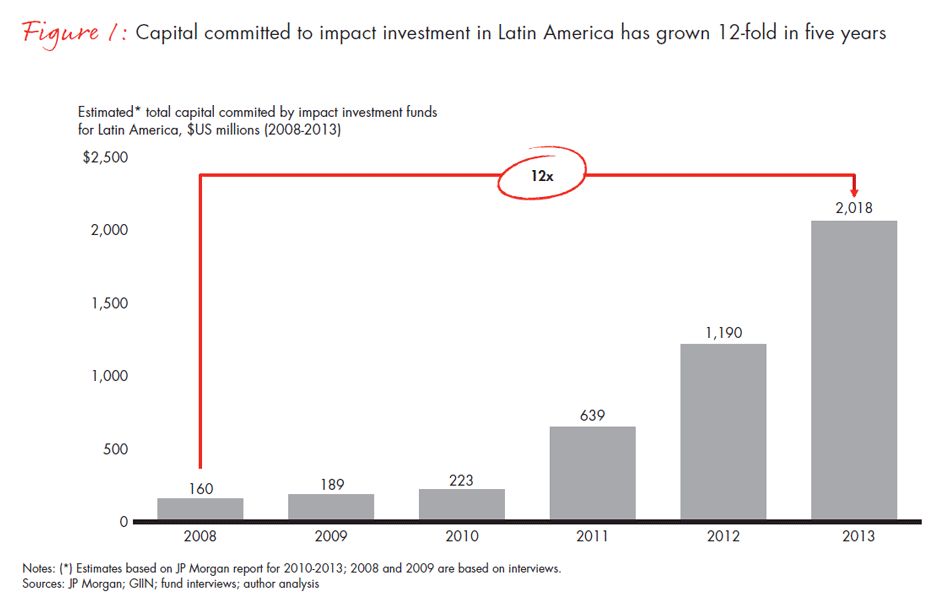
In terms of capital growth, impact investing has definitely arrived—but has it achieved its goals? The answer here is less clear. On the one hand, key challenges have emerged, including a limited investment pipeline, imperfect methods for measuring impact and lack of a legal framework. On the other, despite these challenges, reason for optimism exists. Some early funds have successfully exited initial investments with positive social and financial returns, others have raised second rounds of capital, and hubs of activity have begun to form in cities such as Bogota, Mexico City and São Paulo. Inefficient or ineffective governments continue to leave huge financing gaps for key societal needs unfilled, providing opportunity, and even better, attracting large investors, including pension funds, which have begun to take seriously the idea of making strategic investments in this space.
This report lays out an assessment of the current landscape, some of the critical challenges ahead and the likely path forward over the next 5 to 10 years. The findings are based on interviews with representatives of more than 25 impact investment funds, conducted between November 2013 and March 2014. (A full list of interview subjects is provided in the Appendix.) Primary Internet research of fund websites, as well as other mainstream news sources and international organizations active in this area, also added to these findings.
What is impact investing?
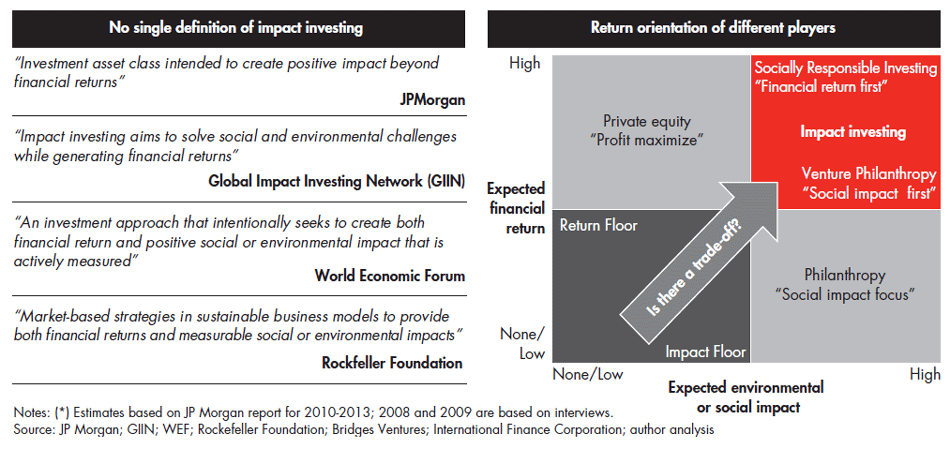
Impact investments aim to provide both measurable financial results and measurable environmental and social changes. The combination of environmental and/or social impacts in addition to financial returns have earned this type of investing the labels double bottom line or triple bottom line. Impact investing is also sometimes called “blended” or “shared value” investing, indicating the simultaneous pursuit of financial return and solutions to societal challenges.
Opinion diverges on whether impact investments are a separate asset class or an investment approach. In its seminal 2010 report, JP Morgan defined impact investment as a separate asset class apart from other alternative investments such as hedge funds, private equity and so on. More recently, the World Economic Forum has described impact investing as an investment approach rather than a separate type of asset for investment. Investment in different asset classes could thus be considered impact investing if, as part of its mission, the investing entity intentionally attempts to create positive social and/or environmental change as well as financial returns as its primary business.
All agree, however, that claiming to take social and/or environmental considerations into account when making investments differs greatly from actually making impact investments. Impact investors explicitly state de jure and measure de facto the types of environmental and social impacts they will generate, and they are held accountable for achieving those goals, just as they are for meeting their financial return goals.
Not all cases present trade-offs between financial and environmental and/or social returns. It is possible—although, granted, not in all cases—to achieve better financial returns through closer attention and management of environmental, social and governance (ESG) dimensions of investments While enhanced ESG can boost financial returns, most fund managers agree that in practice some trade-offs are necessary, and that increasing financial return sometimes comes at the expense of expanding their investments’ social benefits. Thus, impact investors must decide if they will be “financial return first” or “social impact return first” players.
Finally, impact investing should not be confused with socially responsible investing (SRI) or corporate social responsibility (CSR) both of which are carried out by different actors and with different objectives. SRI, also known as ethical investing, is carried out by fund managers to avoid investing in businesses deemed irresponsible or unethical (such as tobacco and oil companies). CSR is a charitable activity engaged upon by corporations.
The current landscape
As of 2013, roughly US$10.6 billion in capital was committed to impact investment funds, of which roughly $5 billion was actually invested. Latin America accounts for approximately 19% of this market, with $2 billion in committed capital. And Latin America represents approximately 16% of the invested capital—roughly $800 million—for which Brazil has the largest regional share, with $180 million invested by impact investment funds and organizations both foreign and domestic. Mexico and Colombia have the next largest shares, with approximately $100 million and $50 million invested, respectively (see Figure 2).3 The global distribution of intention to invest is balanced, with the largest share going to the US, Canada and Europe. But no region has more than a 22% share.
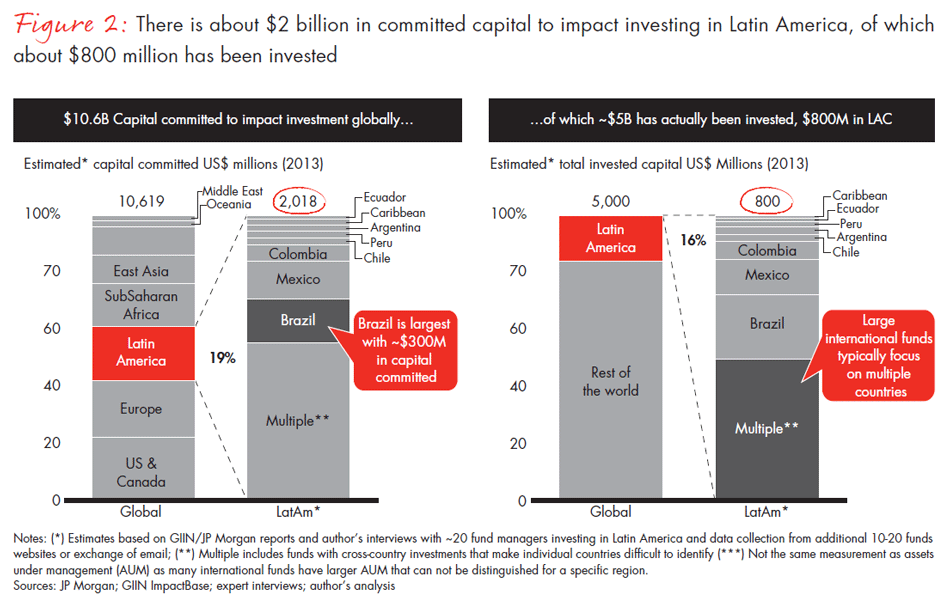
While impact investors in Latin America originally came mainly from abroad, recent trends show an increasing shift toward locally created and developed impact investment funds. Research for this report shows that local funds such as Ignia in Mexico, Inversor in Colombia and Vox Capital in Brazil were among the first movers and have laid the pathway for the more than 40 locally originated funds now headquartered in the region: Roughly 20 of which are in Brazil and about 10 in Mexico, with the rest spread throughout the region.
Although foreign-based funds still out-invest local funds nearly three to one, the local impact funds actually invest in a greater number of investment projects. The presence and growth of local funds are not only critical for their greater numbers of investments; they also often provide capital at earlier stages in the social business venture cycle than do foreign-based funds, and they are better able to navigate the legal and regulatory challenges considered a major constraint on further growth in impact investing in the region.
Most of the region’s impact investment funds surveyed focus on multiple investment themes. Of those that do, the most commonly identified themes are housing, agriculture, education, financial inclusion and health (see Figure 3). The regional impact investment funds taking a single-sector approach most frequently target financial inclusion (or microfinance/microinsurance) and sustainability. This is promising, as these are some of the most critical needs for the base of the region’s population pyramid. This choice is also not surprising, as these activities offer private capital a catalytic role as well as attractive returns.
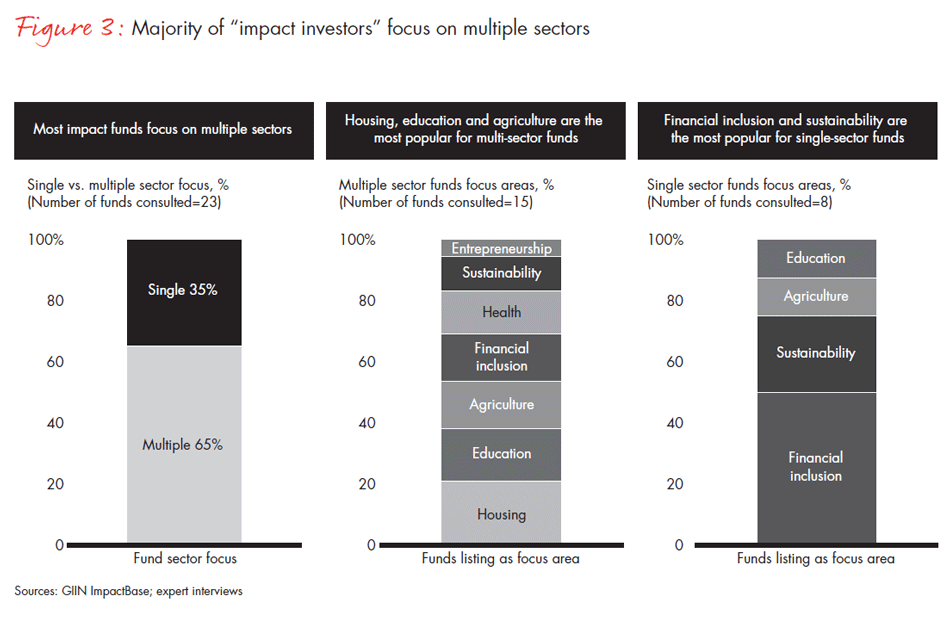
While the most common themes are financial inclusion, agriculture, education and housing, each fund differs in its exact focus. Many of the larger international funds focus on multiple sectors, primarily those related to the region’s development priorities, often as determined by the international community. Other international impact funds are active globally, with a focus on a single sector, typically microfinance; examples include Incofin and Microvest and, in agriculture, Root Capital.
Impact investment funds founded and based in Latin America typically have narrower focuses. Most target the country or a specific region within the country in which they are based, and most focus on at most two or three investment themes, such as housing, education or sustainability. Many have chosen to take an even narrower approach, zeroing in on a single specific sector. This approach guarantees that fund professionals develop deep expertise in that sector, adding value to the investments they make in the space. Examples are Gera Investimentos in Brazil, which decided to focus only on education; EcoEnterprises Fund, which focuses only on sustainability investments in Latin America; and Kaete Investimentos, which focuses on sustainability investments in Brazil’s Amazon region.
The funding model and return orientation of impact investment funds in Latin America varies as well. Impact investment funds are involved in every stage of the venture life cycle (see Figure 4). While most funds work in either the growth or scale stage, a growing number are seed capital providers, crowd funding platforms and accelerators working to increase the pipeline of opportunities.
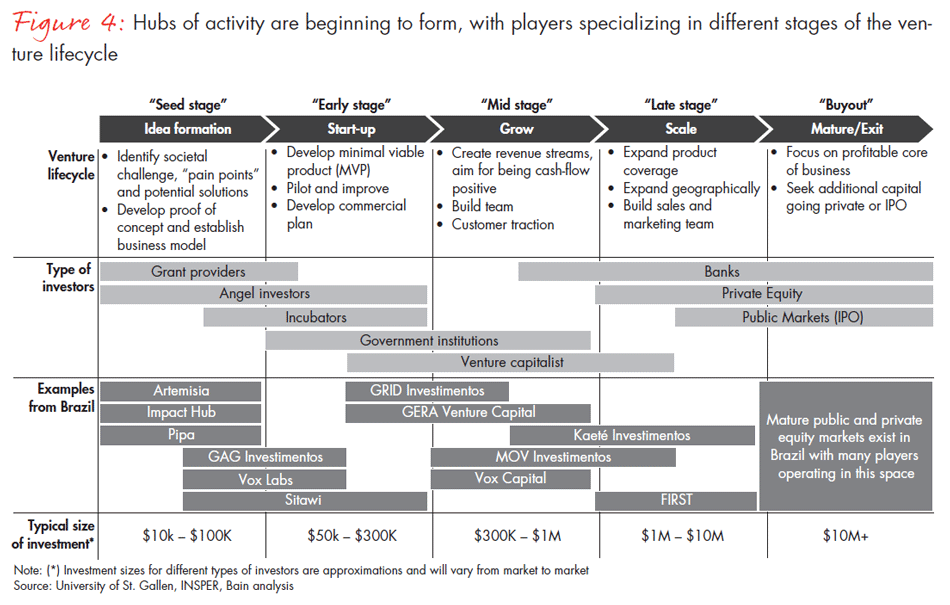
Impact fund return targets in the region depend on the stage of the venture in which the investment is made, as well as on the type of fund and its orientation or philosophy regarding expected returns. Of the funds surveyed, nearly 70% seek to provide fund investors with market or above-market returns—and roughly 20% of funds target opportunities with aggressive 5% and above-market returns. Meanwhile, approximately 10% of interviewed fund professionals report adopting a zero return or self-sustaining approach, asserting that returns could actually reduce intended impacts. Some funds choose to be “impact first” investors rather than “financial return first” players. One such fund is Sitawi, based in Brazil, which sees itself as a nonprofit donor platform for improving the efficiency and efficacy of the funds allocated to social impact projects.
Critical challenges
The last decade of impact investing in Latin America has seen dramatic increases both in the total number of funds and in the capital allocated, but the success of this effort is not yet clear. Although the industry is moving from the phase of “uncoordinated innovation” into “marketplace building,” some key ingredients are still missing, such as the institutional infrastructure needed to support marketplace development (see Figure 5). Funds exist in a wide range of sizes and investment philosophies, with equally varied geographic and sector focuses. It is still too early to draw conclusions about the efficacy of Latin America’s impact investment funds, as objective (hard data) measures of success have been difficult to establish. Despite some early signs of achievement in environmental and social impact investing, many funds continue to face challenges along the entire investment life cycle, which must be addressed before these successes can be seen as enduring realities. The sections below examine some of the most critical of these.
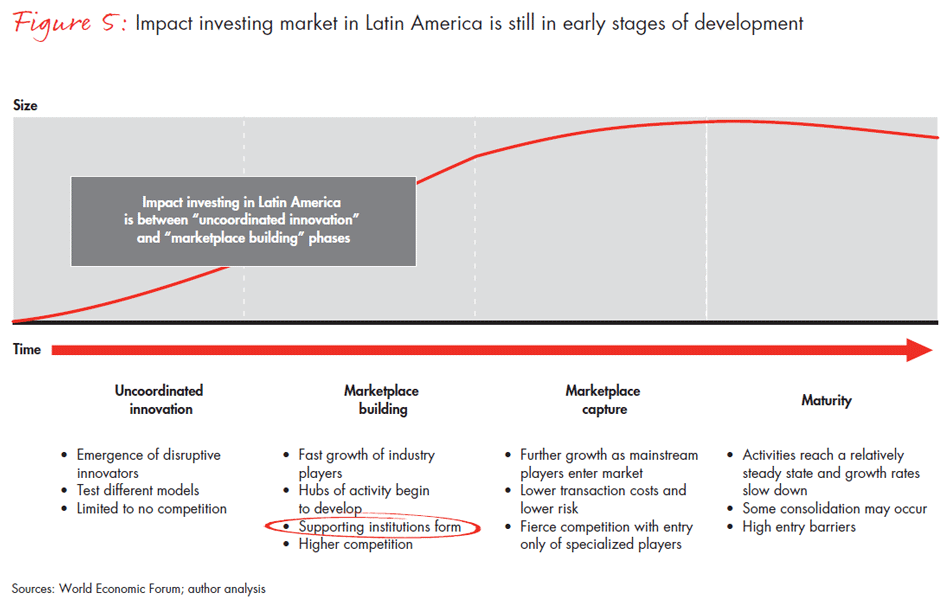
Sourcing investment opportunities
The first challenge facing the impact investing community is how best to deploy capital into projects or ventures with high potential for social, environmental and financial return. Surprisingly, the supply of capital appears to be higher than the demand for capital. Many funds end up competing over the same high-potential investments.
This may seem to suggest either a lack of good social ventures looking for money or a lack of social ventures with returns sufficiently high to attract investors. But the research in this report suggests otherwise: rather, while many good social business ideas are emerging across the region, many of them remain as yet undiscovered. The challenge is not the supply of social business ideas, but the ability of these mostly small and informal ventures to express their ideas in business plans and pitches that meet the requirements of potential investors. Social entrepreneurship and social venture accelerators are still nascent in Latin America, and until more businesses professionalize, excess capital will continue to chase too few opportunities.
Difficulty in measuring impact
Measuring the financial performance of investment funds is very straightforward. Figuring out the right impact metrics for social and environmental returns is less easy, since each investment project addresses a distinct set of social impact issues, among them housing shortages, education quality, poverty and so on. Further, not all value created by impact investments can be easily measured and compared; for example, how do you measure improvements in quality of service provision? In addition, it is not completely clear that the same metrics could or should be used across the globe. Finally, the metrics that do exist—IRIS (Impact Report and Investment Standards) and GIIRS (Global Impact Investing Rating System)—focus more on monitoring and classification than on actually identifying the impact of the investments on the communities in which they are made.
Clearly, measuring social impact is difficult. Setting up randomized trials and extrapolating conclusions across investments, sectors or geographies may not make the best use of the funds’ precious and limited resources. Similarly, the impact measurement frameworks used for policy or government social service programs may not be applicable to the efforts of private portfolio companies. Finally, it is not easy to measure the indirect impacts—such as informing and inspiring follow on innovations—by the investments made.
Despite the difficulty of measuring impact, many funds do believe that the portfolio companies they invest in are achieving or exceeding the expected impact targets. Of the funds interviewed, 75% of fund professionals thought that, even though it was early and investments had not exited, they were meeting impact targets; another 17% thought they were exceeding their original expectations. Only one fund reported it was not achieving its social impact targets (see Figure 6).
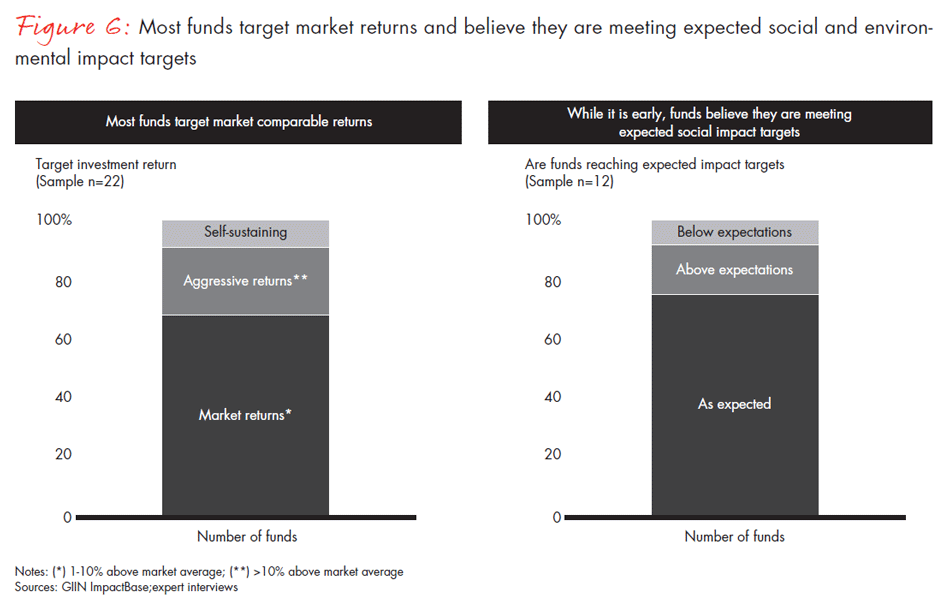
Finding suitable exit opportunities
Impact investment in Latin America is still in an early stage, with most funds not yet looking for suitable exit strategies for their portfolio companies, but it has become clear that this may become a challenge for many. Outside Brazil, Mexico, Chile and Colombia, IPO markets are nascent, and larger companies seeking potential acquisitions have only just begun to awaken to the benefits of social impact business models, leaving unclear the most common exit for impact investment funds or how long they will need to keep companies in their portfolios before exit becomes feasible. Without good exit options, investors putting money into impact investment funds will not attain the good financial returns they seek.
Lack of supporting institutions
Another factor must be added to the above concerns: the confusing and unclear role that governments play in Latin America, both helping and hurting impact investors. Currently, most Latin American countries have no clear legal frameworks for blending social impact and for-profit organizations such as impact investment funds (for example, the B-corporation in the United States). Latin America’s impact investment funds thus face additional uncertainty and higher legal or regulatory risk than do counterpart funds in other parts of the world.
The path ahead
Despite the challenges outlined above, impact investing is firmly grounded in Latin America and will likely continue to grow at a fast rate over the next 5 to 10 years. Three main reasons explain the endurance of impact investment funds in the region and why more business leaders, both in finance and in the real sectors, should take notice of, engage and participate in the growing trend:
Success stories. The first and most important reason for optimism and wider engagement is that, despite the formidable challenges, some of the early impact investment funds in Latin America have begun to show results and raise additional capital.
One of the earliest, Vox Capital in Brazil, was created and raised its first round of capital in 2009. Its first investments were made shortly afterwards, and the company will soon exit many of those investments successfully with the creation of both positive return and social impact. One of the 12 portfolio companies it invested in was Saútil, an online health services company that provides lower-income people with health and wellness information via computer and phone. With the help of Vox’s initial investment of just $50,000, Saútil has, to date, provided access to information about low-cost health services to more than 1.2 million patients in Brazil.4 These patients received access to information they never had before, an unqualified benefit to this underserved population. These social impacts have been measured through internationally accredited agencies, such as GIIRS, and local academic think tanks have confirmed the impacts, contributing to Vox’s success in raising another, larger round of funding in 2013.
Elsewhere, LGT Venture Philanthropy, an impact investor from Liechtenstein, invested US $1.5 million in Lumni to expand operations in Colombia, Chile, Mexico and Peru. Lumni, an innovative human capital/education financing model, has grown rapidly and is praised as one of Latin America’s social enterprise success stories, profitably providing returns to its investors, including BIS, while helping students gain access to education. To date, Lumni has financed nearly 6,000 students’ education, nearly all of whom come from low-income backgrounds; these recipients are often the first members of their families to attend college.5
An impact investment fund concentrating on the environment, the EcoEnterprises Fund, focusing on Central America, has also delivered on its environmental and financial promises in its first investment portfolio. The first portfolio created more than 3,500 jobs and conserved nearly a million hectares of land, benefiting 293 communities and conservation groups.6 Thanks to that success, it has raised a second fund and is currently invested in successful businesses, including Runa, an Amazon rainforest tea export and bottling business.
These stories demonstrate the potential for other funds to build similar successes.
Marketplace development. Another promising impact investing development is the move from the period of uncoordinated innovation and new fund creation that took place between 2009 and 2011 to the next stage: formation of clusters of activity and coordination of activities. Over the last few years, clusters have emerged in large Latin American cities, such as Bogota, Mexico City and São Paulo (each with 5 to 10-plus funds). Pools of impact invest-ment funds have emerged, the members of which have begun to coordinate and act together. By creating hubs of activity, needed legal and regulatory infrastructure can be built, lowering the transaction costs of doing business and attracting additional outside capital.
As these hubs of activity begin to formulate, the funds themselves also start to focus on different stages of social business needs. More niche investors emerge and a broader range of specialized capital and assistance becomes available. This is the case in São Paulo, Brazil, where different impact investors have begun to focus on different stages of venture needs.
At the idea-formation stage, there are players like Artemesia, which provides a platform for social entrepreneurs to meet, receive training and test their initial business ideas. Then there are others, like Vox Labs,7 which are accelerators providing initial seed capital for existing ventures; these accelerators enable ideas to grow and business models to be tested, and they help prepare the companies for larger investment. Once the business model has been proven, there are several funds providing capital for the growth stage. In this scenario, investors like GRID Investimentos, are looking for game-changing technology opportunities that will grow quickly. Finally, there are the scale investors—those with larger pools of capital, such as MOV Investimentos, who would like to place larger amounts of capital into social businesses that already have some size and would like to scale.
Huge remaining needs. The final reason for optimism is the growing recognition that investment opportunities abound. While government plays the central role in providing social services and public goods to society, in Latin America and the Caribbean these efforts have nevertheless resulted in glaring unmet needs. More than 80 million people live in extreme poverty,8 54 million families live in inadequate housing,9 the quality of education has de-teriorated despite greater access10 and climate change risks threaten food security even in Latin America, which has some of the world’s most abundantly producing agricultural lands.11
Existing national government spending and international aid simply cannot meet all these needs. A UNESCO study from 2012 found that, even considering government expenditure and actual foreign aid donated to Latin America, a gap in funding of approximately US$10 billion remained for meeting basic and tertiary education costs across the region.12 Impact investment funds and social enterprises will be needed to help fill that gap if Latin America is to develop commensurate with its human and natural resources and potential.
Conclusion
Despite the impressive growth of impact investing in Latin America the last few years, the region is in the early stages of development and many challenges and obstacles remain. Still, there is plenty of reason for optimism. Hubs of activity have been forming in cities like Bogota, Mexico City and São Paulo in response to early successes, and a larger pool of both local and overseas investors keen to make money and make a positive difference in people’s lives continue to invest more every year in this key market. This presents an incredible opportunity to create and scale social impacts across the region. We hope the opportunity is not wasted.
To read the appendix, download the full PDF.
Case study: Example of government actions to support the impact investment marketplace in the United Kingdom
The UK, along with the US, has been at the forefront of impact investing from day one. Thus it is no surprise that it also provides examples of good practices in supporting policies and institutions to help build the impact investing ecosystem in Latin America. The most notable of the many UK government efforts to support the industry include:
Stimulating demand for social businesses through legislation. In early 2013, the UK government implemented the Public Services (Social Value) Act,* which requires public authorities to incorporate
not just economic but also social and environmental well-being into public service contracts. This legislation incentivizes the growth of businesses that explicate, target and measure social and environmental benefits, increasing dramatically the pool of investment opportunities for impact investment funds in the UK.
Increasing social investment supply through tax incentives. As of April 2014, the UK government implemented a new provision to the tax code called Social Investment Tax Relief (SITR). SITR provides up to a 30% tax break for a maximum investment of £290,000 over three years. These tax breaks provide strong incentives for impact investment players to provide more capital to the UK market and, therefore, the right conditions for social enterprises to grow.**
Building supporting institutions. While not formally a government activity, the UK has pioneered the development of the most innovative third-sector institutions supporting impact investing in the country and globally. One of the first nonprofit organizations built to support the growth of impact investing is Social Finance UK, created in 2007.*** Its primary role has been to push for new approaches to using finance to solve social problems, but it has also led the way to the establishment,
also in 2011, of Big Society Capital, one the UK’s first social venture funds; the widespread use of social impact bonds by the UK. government; and the push for changes in legislation and policy such as those mentioned above.
* Available at http://www.legislation.gov.uk/ukpga/2012/3/enacted?view=plain
** Wragge&Co LLP. “The Role of Tax Incentives in Encouraging Social Investment.” London: The City of London and Big Society Capital; 2013.
*** Social Finance UK website: http://www.socialfinance.org.uk/
Andre Leme and Fernando Martins are partners and Kusi Hornberger is a consultant in Bain & Company’s São Paulo office.
Cover photo in duotone, by Maria Ly from Flickr (www.flickr.com/photos/mariachily/).
1. From ANDE, World Economic Forum, JP Morgan, GIIN, LAVCA and others.
2. Estimates based on the JP Morgan report “Spotlight on the Market: The Impact Investor Survey,” 2014, and interviews with more than 25 fund managers between November 2013 and March 2014.
3. Note that some of the largest international funds do not designate specific value per country and thus have allocated capital to the region as a whole rather than to specific countries.
4. Saútil website: www.sautil.com.br
5. Lumni website: www.lumni.net
6. Based on information available on EcoEnterprises website: http://www.ecoenterprisesfund.com/index.php/impact
7. The Vox Labs program arose from Vox Capital’s need and interest in supporting the growth and development of companies at an earlier stage of the venture cycle.
8. World Bank, “Shifting Gears to Accelerate Shared Prosperity in Latin America and the Caribbean,” World Bank Press, June 2013.
9. A. Blanco, et al., “Rental Housing Wanted: Policy Options for Latin America and the Caribbean,” Inter-American Development Bank Press, 2014.
10. E. Hanushek, “Schooling, Educational Achievement and the Latin American Growth Puzzle,” Journal of Development Economics, November 2012.
11. Intergovernmental Panel on Climate Change (IPCC), “Climate Change 2013: The Physical Science Basis”; Geneva, Switzerland; 2013.
12. UNESCO. “Youth and Skills: Putting Education to Work.” Paris, France: UNESCO; 2012.






